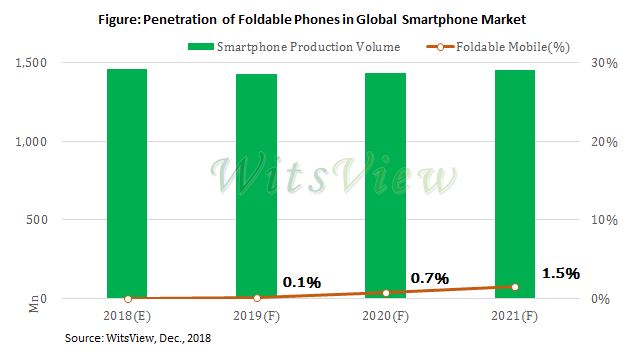- Ameya360 Component Supply Platform >
- Trade news >
- Foldable Smartphones to Be Launched in 2019 with Penetration Rate of 0.1%
Foldable Smartphones to Be Launched in 2019 with Penetration Rate of 0.1%
According to The Future of Smartphone Era Webinar by WitsView, a division of TrendForce, the global smartphone market has been approaching saturation, with less room for product differentiation. Thus, smartphone makers have shifted their focus to next-generation foldable models. WitsView expects the first foldable smartphone to be launched in 2019, accounting for only 0.1% in the global smartphone market. The penetration rate is estimated to reach 1.5% in 2021.
According to Boyce Fan, the research director of WitsView, a few manufacturers tried to develop foldable models in the past using a dual-screen design, but most of them failed. However, as breakthroughs continue to be made during the development of flexible AMOLED panels, single-screen foldable smartphones gradually emerge. Among the makers, Samsung takes a leading role with its advanced display technology.
Product differentiation is harder with a more saturated market, impacting Samsung’s smartphone business in recent years. Its AMOLED models can no longer trigger strong demand as before. Together with increasing competition from Chinese smartphone brands in the emerging markets, Samsung’s smartphone business has come to a bottleneck and needs new demand momentum for growth. Therefore, WitsView believes that Samsung is highly like to release the first foldable smartphone in the market next year as an attempt not only to define a new concept for smartphone hardware, but to consolidate its leading position in the global smartphone market.
Although foldable phones have become the focus of the market, they still remain in the early stage of product development, so manufacturers are bound to improve the designs continuously, says Fan. Samsung’s current concept foldable phone adopts an inward folding design, which requires an extra display outside for the front cover. Thus a key to good user experience will be the interface optimization for the transition between the display inside and outside. Meanwhile, there is also room for improvement in terms of the thickness of the phone and the border, as well as the battery life.
The design of outward folding is an alternative considered by many manufacturers, but it involves additional challenges like how to balance the strength, thickness and flexibility of the protective CPI films or protective cover glass, and how to increase the display materials’ ductility, malleability, and credibility when folded. Therefore, the time needed for developing outward folding phones would be even longer.
In addition to Samsung, other smartphone vendors like Huawei, LG, Google and Lenovo have started to plan for launching foldable models, but even longer time is needed because they are still constrained by the lack of alternative panel suppliers other than Samsung. WitsView believes that the initial demand for foldable smartphones will not be very strong, considering the need for product optimization, lack of flexible AMOLED panel suppliers other than Samsung, and the looming demand in the market. The segment of foldable smartphones will not have a chance to expand until the second half of 2019 or after 2020, when more manufacturers follow suit to launch foldable models and get more feedback from the market.

Online messageinquiry

Growth Expected to Return to Smartphones
- Week of hot material
- Material in short supply seckilling
| model | brand | Quote |
|---|---|---|
| CDZVT2R20B | ROHM Semiconductor | |
| MC33074DR2G | onsemi | |
| RB751G-40T2R | ROHM Semiconductor | |
| TL431ACLPR | Texas Instruments | |
| BD71847AMWV-E2 | ROHM Semiconductor |
| model | brand | To snap up |
|---|---|---|
| STM32F429IGT6 | STMicroelectronics | |
| BP3621 | ROHM Semiconductor | |
| TPS63050YFFR | Texas Instruments | |
| BU33JA2MNVX-CTL | ROHM Semiconductor | |
| IPZ40N04S5L4R8ATMA1 | Infineon Technologies | |
| ESR03EZPJ151 | ROHM Semiconductor |
- Week of ranking
- Month ranking
Qr code of ameya360 official account
Identify TWO-DIMENSIONAL code, you can pay attention to


Please enter the verification code in the image below:























